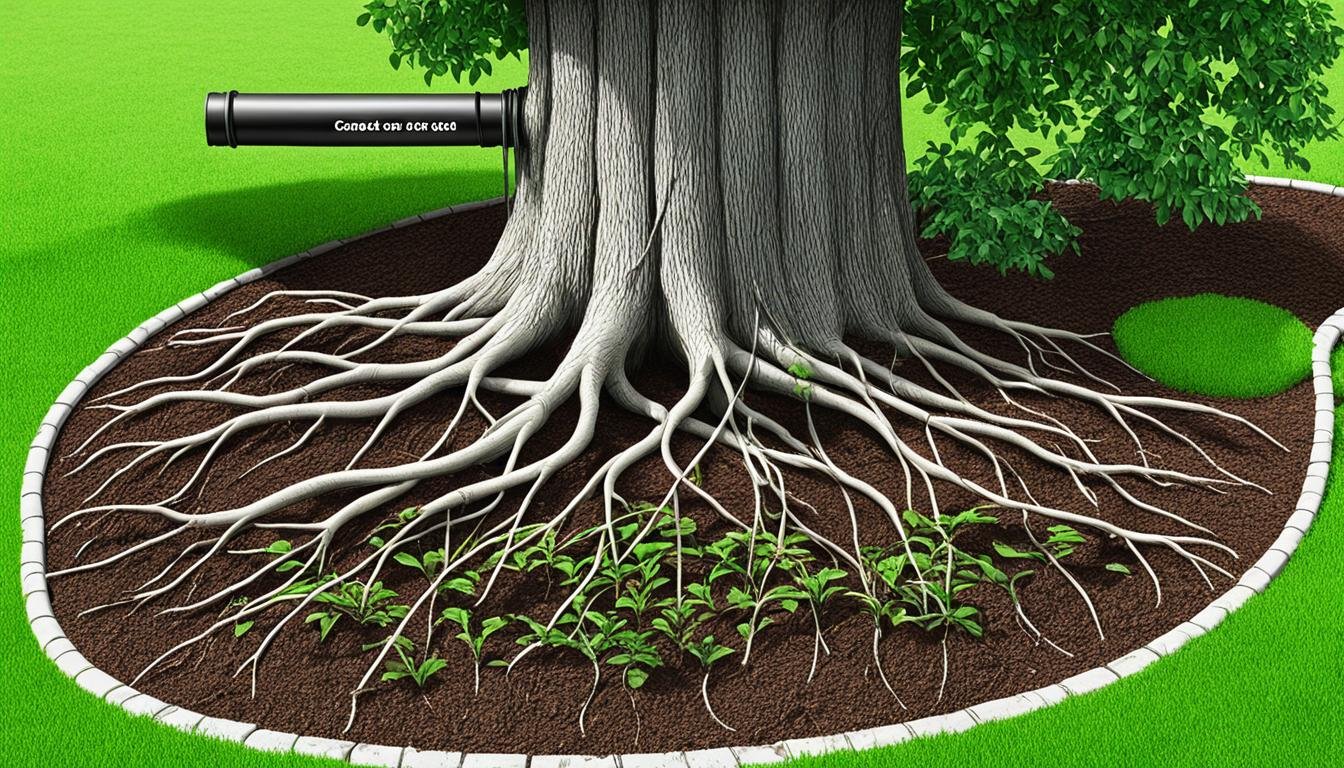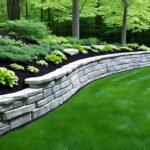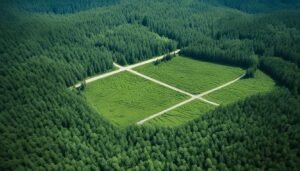
Did you know that trees often receive inadequate watering, leading to stunted growth and poor health? Proper tree watering is essential for their overall well-being. To ensure your trees thrive, it’s crucial to install a drip irrigation system specifically designed for trees. This efficient method delivers water directly to the tree’s root zone, promoting deep root growth and reducing water waste.
Key Takeaways:
- Installing drip irrigation for trees is vital to their health and growth.
- Water trees deeply to a depth of at least 18 inches.
- Use a drip irrigation system to deliver water directly to the root zone.
- An innovative solution is the Root Watering System (RWS) developed by Rain Bird.
- Regulate the amount of water using an irrigation timer or controller to avoid overwatering.
Why Choose Drip Irrigation for Fruit Trees
Drip irrigation offers several advantages for fruit trees. Firstly, it promotes efficient water usage by minimizing evaporation and delivering water directly to the root zone. This helps save water and reduces water waste, making it an environmentally friendly option for irrigation. Additionally, drip irrigation provides flexibility in timing as it is not affected by wind like sprinkler systems, allowing for precise control over watering schedules.
However, there are also disadvantages to consider. One potential drawback is the potential for emitters to clog, especially in smaller tubing. Regular maintenance and filtration can help mitigate this issue. The layout of drip tubing and emitters is crucial for effective watering. There are various methods for the physical layout, including single or double lines, pigtails, or rings, depending on the specific needs of the fruit tree.
“Drip irrigation is an efficient and precise method of watering fruit trees.”
How Drip Irrigation Works for Fruit Trees
Drip irrigation works by delivering water at a few points under the tree’s canopy. It then spreads laterally through the soil, effectively wetting a larger volume of dirt. This targeted watering technique ensures that water reaches the roots where it is needed most, promoting healthy root growth and overall tree health.
Number of Emitters and Watering Schedule
The number of emitters needed for fruit trees depends on the size of the plant’s root area. As a general rule of thumb, it is recommended to have at least one emitter per foot of canopy diameter. However, it is important to adjust the drip irrigation system as the tree grows, either by running the system for longer durations or by adding more emitters to adequately meet the tree’s increasing water needs.
The watering schedule for fruit trees on drip irrigation will vary depending on factors such as local climate, soil type, and tree species. Monitoring the moisture levels in the soil is crucial in determining the frequency and duration of irrigation. Aim to keep the soil consistently moist but not waterlogged to avoid potential issues such as root rot.
| Advantages of Drip Irrigation for Fruit Trees | Disadvantages of Drip Irrigation for Fruit Trees |
|---|---|
|
|
Design Considerations for Drip Irrigation Systems
When designing a drip irrigation system, there are several important factors to consider in order to ensure its effectiveness and efficiency. One of the key considerations is water cleanliness, as clean water is essential to prevent clogging of the emitters. It is recommended to use a filtration system to remove any impurities or debris that might hinder the proper functioning of the system.
Pressure regulation is another crucial aspect of drip irrigation design. Most drip systems operate at a pressure range of 10 to 30 PSI (pounds per square inch), and maintaining consistent pressure is essential for optimal performance. Pressure regulators can be installed to ensure that the water is delivered at the right pressure level to the emitters.
Elevation changes should also be taken into account when designing a drip irrigation system. As the elevation changes, so does the pressure. It is important to calculate the specific pressure changes with each foot of elevation to ensure uniform water distribution throughout the system.
The wetting area for each plant is an important consideration to ensure that the plants receive adequate water for their growth and development. Ideally, the system should be designed to wet at least 50% of the root area of each plant, with a target of 60% or more for optimal growth. This can be achieved by strategically placing the emitters and adjusting their flow rates.
When determining the water use per plant, factors such as the plant’s area, specific water needs (plant factor), potential evapotranspiration, and the efficiency of the drip system should be taken into consideration. This information can help in calculating the amount of water required for each plant and how long the irrigation system should run.
The emitter spacing and numbers will depend on the soil texture, water requirements of the plants, and the desired wetting area. It is important to ensure that the emitters are placed above ground for easy visual inspection and to prevent root intrusion. Additionally, special low-pressure backflow preventers should be used when connecting the irrigation system to culinary water systems to prevent any contamination.
In conclusion, careful planning and consideration of these design considerations are crucial for designing an effective drip irrigation system for trees. By ensuring water cleanliness, pressure regulation, proper wetting area for each plant, and accurately determining water use per plant, you can create a system that promotes plant health, conserves water, and maximizes irrigation efficiency.






No comment yet, add your voice below!